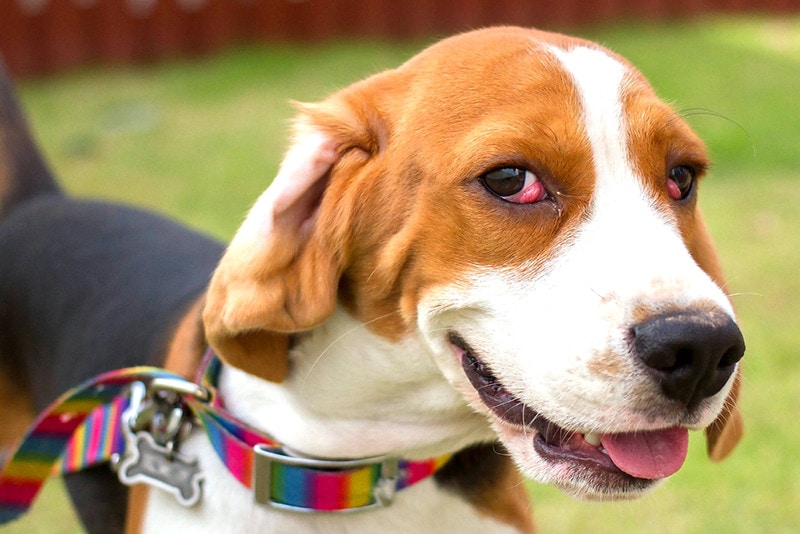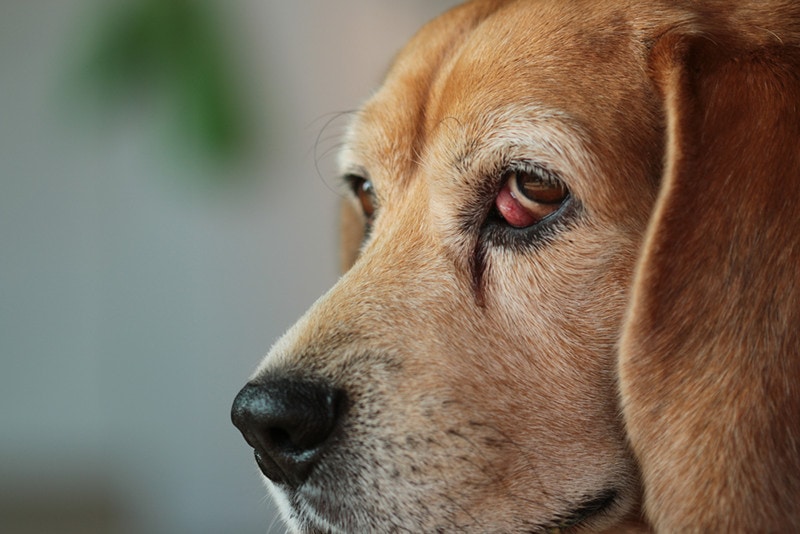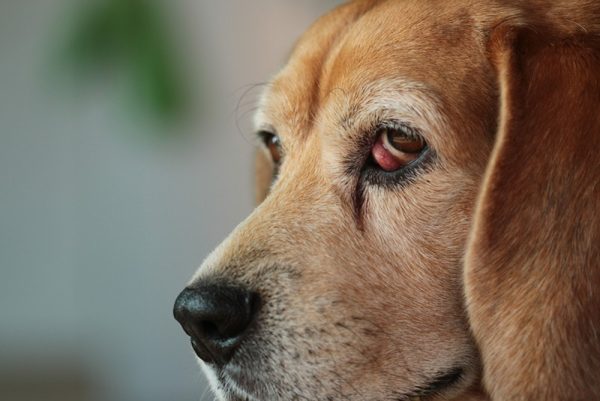You may have heard the term “cherry eye” before but are unsure what it means. Does it hurt your dog? How can you treat it? When should you be concerned? Cherry eye can be found in any breed, including your Beagle. Continue reading to learn more about what cherry eye is, what it looks like, and what your treatment options are if your beagle has a cherry eye.
What Is a Cherry Eye?
Cherry Eye is the generic or lay term for a prolapsed gland of the nicitans. The gland of the nicitans is also known as the third eyelid, and is one of the glands associated with your dogs’ eye that produces tears. The third eyelid is found on the inner corner of each eye, closest to the nose. You may notice a small, pink triangular piece of tissue in this area. Normally, this area is flat, pink and barely noticeable.
When a dog suffers from cherry eye, this gland actually becomes prolapsed, or pops out of its’ normal position. This can occur to one or both eyes of your beagle and can vary in severity to the amount the gland is displaced.

What Are the Signs of Cherry Eye in a Beagle?
When you look at your beagles’ healthy eye, you should barely notice a small, healthy pink triangular piece of tissue on the inner corner of each eye. When your beagle is sleepy, you may notice these glands cover a large portion of the eye to help protect the globe as they sleep.
When cherry eye occurs, this gland will prolapse out of its’ normal position and appear as a small, pink or red-colored round swelling at the corner of the eye. This round swelling has the appearance of a very small cherry, hence the name. The color can range from bubble gum pink to dark red, and the size can be small or appear to protrude over a large portion of the eyeball. Cherry eye can occur in one or both eyes, sometimes at the same time.
This condition is non-painful. Therefore, your beagle will likely not notice anything is wrong. They typically will not be pawing at the eye, trying to hold it shut, experiencing any discharge or crusting of the eye. Because this gland helps produce tears for the eyes, your dogs’ eyes may become dry and irritated with time.
If dry eye occurs, that can be a very uncomfortable and even painful condition to your dog. You may notice redness to the whites of the eye, increased crusting around the eyes and/or general irritation. Eye dryness is not something that occurs acutely but over time if the cherry eye is not treated.

What Are the Causes of a Cherry Eye in a Beagle?
The third eyelid is normally held in place by a small, fibrous attachment. In beagles, it’s theorized that this attachment can become weak and break down, causing the third eyelid to prolapse. However, there are no good studies to support this theory.
Cherry eye is more common in brachycephalic, or the squish-faced dogs such as Bulldogs, Boston terriers and Shih Tzus. This is more likely because the eyes in these dogs often protrude out farther from the eye socket than other dogs. This is not the case with beagles.
Cherry eye occurs most commonly in dogs less than a few years of age, with some even being affected as young puppies. Dogs can have either one or both eyes affected.
How Do I Care for a Beagle With Cherry Eye
The biggest concern with cherry eye is the development of dry eye. As discussed above, a cherry eye is typically a non-painful condition. However, if tear production is affected, and/or tear protection of the eye(s) is affected, dry eye can occur and can be painful. Your beagle may develop redness to the white of the eyes, crusting, squinting and discomfort.
When you first notice a cherry eye in your dog, you should make an appointment to see your veterinarian. Depending on your dogs’ age, the severity of the cherry eye, their breed and other underlying health issues, your veterinarian will discuss medical management or surgery. Medical management involves applying artificial tears one to a few times a day to help combat dry eye. This may be all your dog needs. However, some dogs will benefit from surgery. Surgery involves making a small “pocket” in the tissue to replace the gland. This little pocket is then sutured close to keep it in place.
An older surgical procedure involves completely removing the prolapsed gland. This is no longer recommended because then this gland that helps supply tears is taken away. If your veterinarian recommends this older procedure, you may want to seek out a second opinion. Some veterinarians don’t perform the newer surgical procedure but they should be able to recommend another veterinarian to help your dog.

Frequently Asked Questions (FAQ)
Will the Surgery Cure My Beagles Cherry Eye?
The surgery to replace the gland into a small pocket of tissue will resolve the cherry eye. However, it can occur again in the future, requiring another surgery.
What if I Don’t Get Surgery for My Dog?
Managing your beagles’ cherry eye with your veterinarian is recommended. The most important thing is to make sure that your beagle does not develop dry eye. This can sometimes be treated with artificial tears, but some dogs will require more specialized medications for tear production.
Conclusion
Beagle cherry eye is a condition most commonly seen in younger dogs. Cherry eye actually refers to the prolapse of the third eyelid, or a tear gland. Some beagles may require surgery for this condition if the prolapse obscures their vision and/or causes dry eye. Other times your dog may be fine with no treatment aside from artificial tears. If you notice that your beagle has a cherry eye, always follow up with your regular veterinarian for monitoring and treatment. If your beagles eye seems irritated, red or painful at any time, veterinary care should be sought immediately.
Related Read:
- https://pThere’s a Bump on My Dog’s Eye: Should I Worry?etkeen.com/bump-on-dogs-eye-vet-answer/
- 9 Common Eye Problems for Dogs
Featured Image Credit: jukgrapong, Shutterstock












